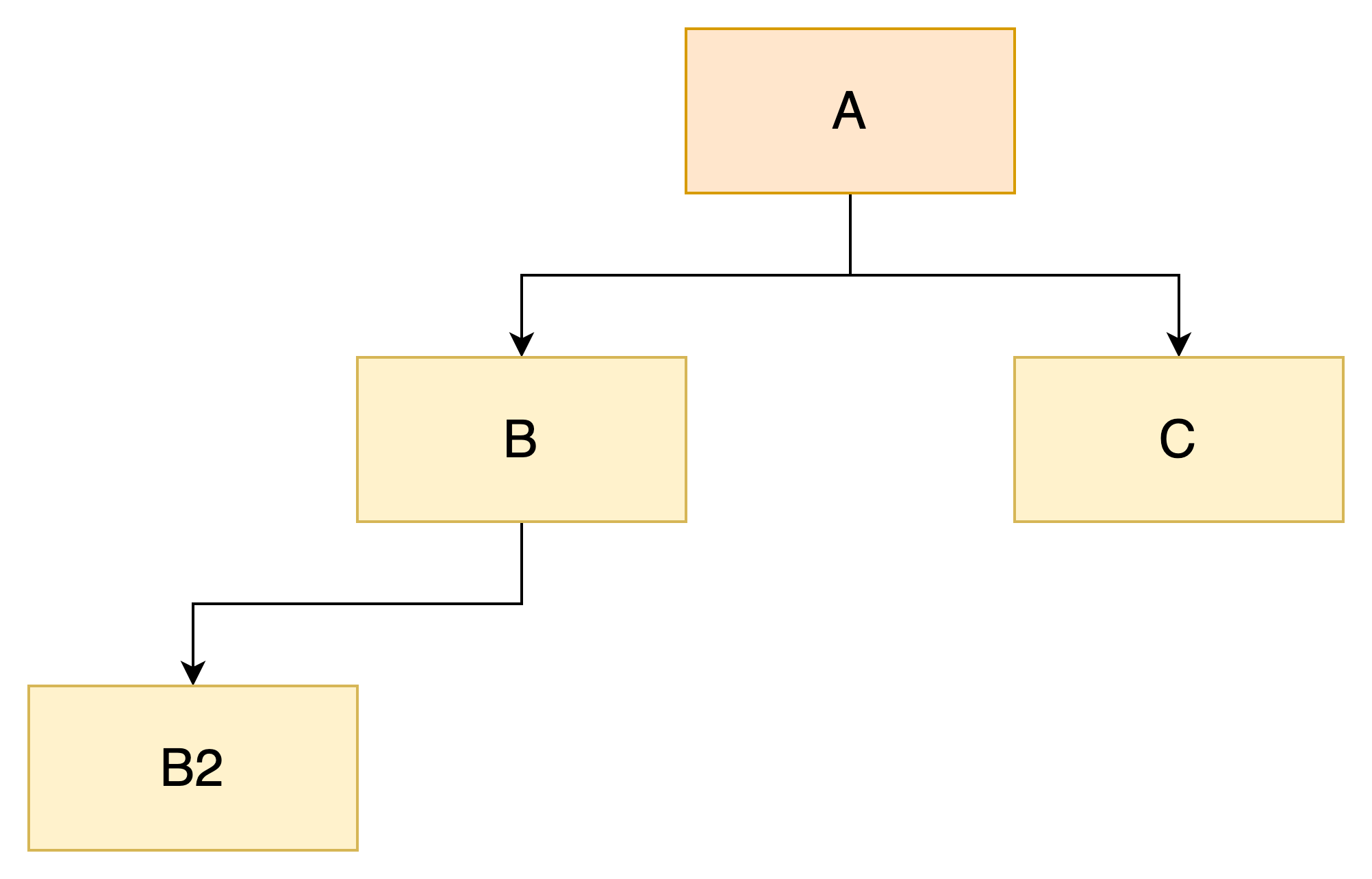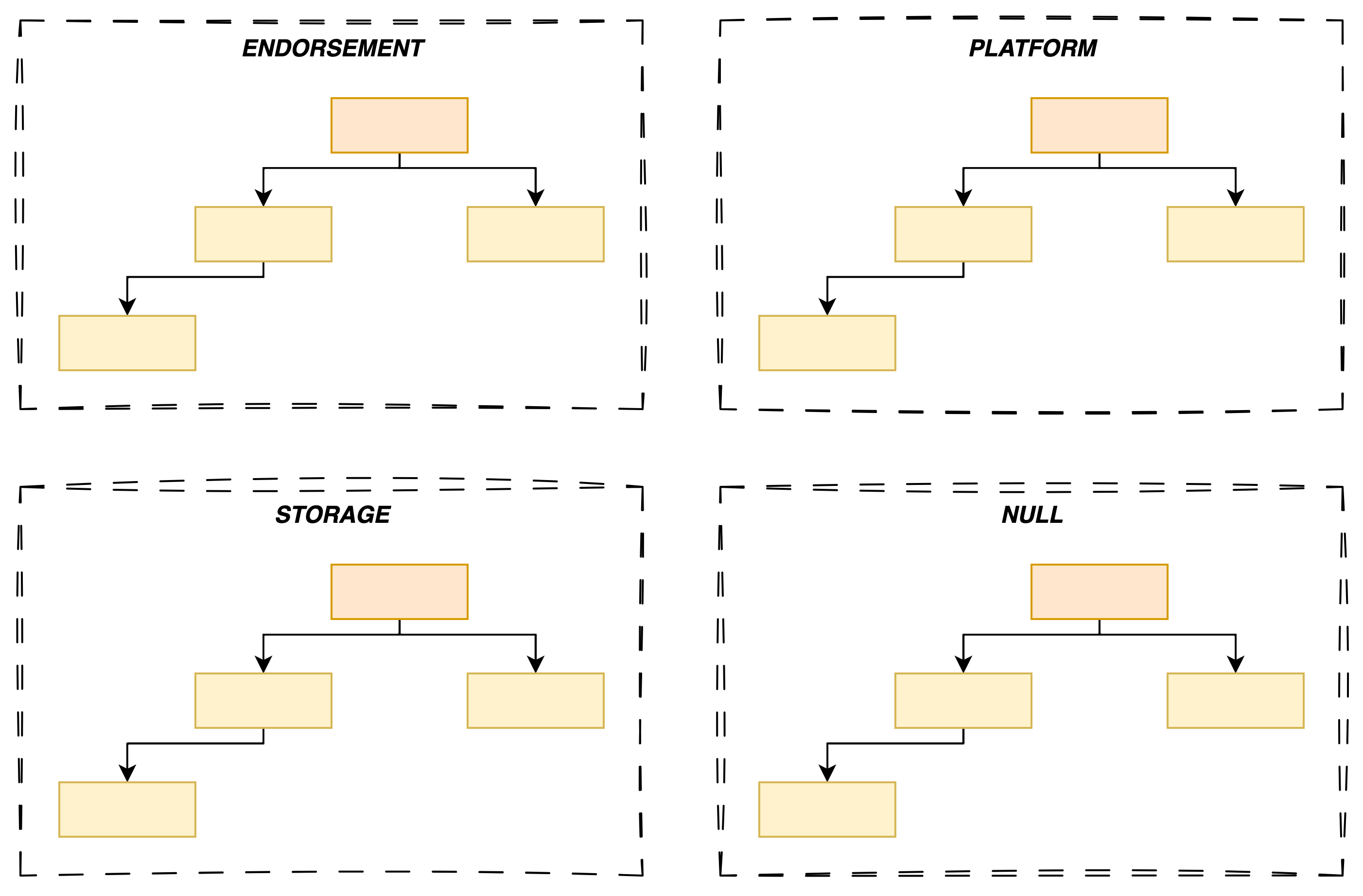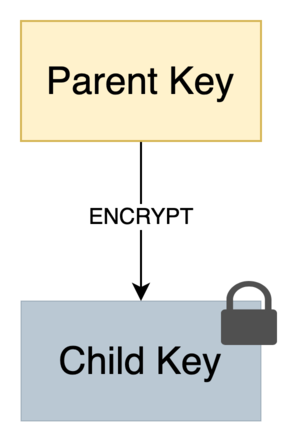Create a TPM key
Let’s start by introducing few concepts before getting our hands dirty.
Concepts
Key Hierarchy
A TPM manages its keys in a rather unique way by applying the principle of hierarchy.
Let's analyze the diagram below to better understand this concept:

The diagram represents a tree with the following relationships:
Ais the parent ofBandCBis the parent ofB2
This model directly maps to how a TPM organizes its keys, which are divided into two types:
- Primary key: a resource with no parent (e.g.,
A) - Ordinary key: a resource that has a parent (e.g.,
B,B2, andC)
Notes:
- A key has only one parent
- An ordinary key can itself be the parent of another key (e.g.,
B)- A key can have multiple children (e.g.,
A)
This parent/child distinction explains why two separate commands exist for key creation:
TPM2_CreatePrimary: creates a primary keyTPM2_Create: creates an ordinary key (which requires a reference to a parent key)
Moreover, all keys belong to a specific tenant referred to as a hierarchy in the TPM specification1 which I admit can be confusing. Each TPM 2.0 implementation provides exactly four fixed tenants/hierarchies, which can be disabled if needed2.
What is the rationale behind this design?
The spec assumes a TPM may be used in different contexts, so fine-grained access control is needed to support multiple roles. Each hierarchy has its own independent authorization scheme2.
Below is a full list of hierarchies:
| Name | Purpose | Type |
|---|---|---|
| Storage or Owner hierarchy | Intended for non-privacy-sentive operations by the platform owner (e.g., an IT department, the end user). | Persisted |
| Platform hierarchy | Intended to be under the control of the platform manufacturer3 for early boot tasks (e.g., BIOS, UEFI). In other words, it's not meant to be used by the end user. | Persisted |
| Endorsement hierarchy | Intended for privacy-sentive operations when the user or an organization has privacy concerns. | Persisted |
| Null hierarchy | Intended to store ephemeral objects (e.g. sessions, context, etc.) used internally by the TPM. The end user can use this hierarchy to use ephemeral keys that will be erased at reboot. | Volatile |
Table: Four TPM hierarchies
Privacy refers to mecanisms which prevent a third party from correlating or identifying that multiple keys originate from the same TPM.
Note: in a enterprise context, the opposite may be desirable for auditing and control purposes.
The diagram below summarizes the key ideas we've just covered:

Most of the time, you will only use the Storage and Endorsement hierarchies.
Exceptionally, you may need to use the Null hierarchy if ephemerality is a requirement.
Reproducibility
Reproducibility is a fundamental primitive in a TPM. Indeed, the latter can regenerate a Primary Key bit-for-bit, eliminating the need for backups — at least for this kind of keys.
How does this work?
Each hierarchy is tied to a seed4, a complex string of characters generated randomly by the TPM and never exportable. When creating a key, the client provides inputs that describe the key’s desired characteristics. The TPM then derives the actual key using a Key Derivation Function (KDF)5, with two parameters: the inputs and the seed.
We can express this as the following equation:
\( KDF(inputsX, seedY) = keyXY \)
Since the seed is typically stable, the TPM can deterministically reproduce the key whenever needed.
Note: given the high entropy of seeds, it’s extremely unlikely that two TPMs will generate the same key.
Persisted vs. Volatile Hierarchies
Earlier, we distinguished between persisted and volatile hierarchies. Now that the seed concept has been introduced, we can clarify this:
- A persisted hierarchy maintains the same seed across reboots.
- A volatile hierarchy, by contrast, generates a new seed on every reboot, making its keys ephemeral.
With sufficient privileges, it's possible to force a seed rotation for any persisted hierarchy — but this will invalidate all previously created keys.
Use this operation with caution.
Key Attributes
When creating a key, you define its properties through a set of attributes.
Here’s a non-exhaustive list of possible attributes:
| Name | Description |
|---|---|
sign | The key can sign data |
decrypt | The key can decrypt data (it previously encrypted) |
restricted | The key can sign or encrypt internal TPM data |
fixedTPM | The key cannot be duplicated |
fixedParent | The key cannot be duplicated to another parent |
sensitiveDataOrigin | The key was generated by the TPM itself6 |
Table: Key Attributes
A complete list is available here.
Typically, you will combine these attributes based on your use case.
Example: A Parent Key
As mentioned above in the key hierarchy section, a key can act as a parent to others. The TPM spec mandates that such a key conforms to the following pattern:
| sign | decrypt | restricted |
|---|---|---|
| 0 | 1 | 1 |
Why?
A TPM has limited storage. To manage keys securely outside the TPM (e.g., on disk), the parent key must be able to encrypt the private portion (i.e. TPM2B_PRIVATE) of its children.

Later, when the private key is loaded into the TPM, the parent key decrypts the blob. Since TPM2B_PRIVATE is treated as an internal TPM resource, the key must have the restricted attribute.
In the spec, this kind of key is also called a Storage Parent.
A Practical Example
Now that we’ve covered the main ideas, let’s get hands-on!
- Create an ECC NIST P256 ordinary key (requires creating a primary key first)
- Store the key on the filesystem
- Load the key into the TPM
Creating the Primary Key
We start by creating the root key in the hierarchy. It MUST have both restricted and decrypt attributes set to TRUE to be considered a Storage Key. We provide this information to the TPM2_CreatePrimary command as shown in the snippet below:
// without error handling for more clarity
createPrimaryCmd := tpm2.CreatePrimary{
PrimaryHandle: tpm2.TPMRHOwner, // indicates in which hierarchy the key must belong (Owner == Storage)
InPublic: tpm2.New2B(tpm2.TPMTPublic{
Type: tpm2.TPMAlgECC, // type of key
NameAlg: tpm2.TPMAlgSHA256,
ObjectAttributes: tpm2.TPMAObject{
FixedTPM: true,
FixedParent: true,
SensitiveDataOrigin: true, // indicates that the key must be produced by the TPM
UserWithAuth: true,
// required attributes to get a storage key ⬇️
Restricted: true,
Decrypt: true,
SignEncrypt false,
},
Parameters: ... // truncated
})
}
createPrimaryRsp, _ := createPrimaryCmd.Execute(tpm)
Creating the Ordinary Key
With the Storage Key created, we now have everything we need to create an ordinary key using the TPM2_Create command.
// without error handling for more clarity
createRsp, _ := tpm2.Create{
ParentHandle: tpm2.NamedHandle{ // indicates a reference to the parent (i.e. storage key)
Name: createPrimaryRsp.Name,
Handle: createPrimaryRsp.ObjectHandle,
},
InPublic: template,
}.Execute(tpm)
TPM2_Create's response contains the following fields:
| Type | Name | Description |
|---|---|---|
| TPM2B_PRIVATE | outPrivate | the private portion of the object |
| TPM2B_PUBLIC | outPublic | the public portion of the created object |
| TPM2B_CREATION_DATA | creationData | contains a TPMS_CREATION_DATA |
| TPM2B_DIGEST | creationHash | digest of creationData.creationData using |
| nameAlg of outPublic | ||
| TPMT_TK_CREATION | creationTicket | ticket used by TPM2_CertifyCreation() to validate |
| that the creation data was produced by the TPM |
Table: TPM2_Create Response
The result contains two important fields: outPrivate and outPublic, which can safely be stored on disk because:
TPM2B_PUBLICis meant to be publicTPM2B_PRIVATEis opaque (because encrypted by the parent key)
Due to the TPM's limited resources, keys are typically stored externally.
Loading the Ordinary Key
To load a key into the TPM, we need to use TPM2_Load command along with TPM2B_PUBLIC and TPM2B_PRIVATE data.
// without error handling for more clarity
loadRsp, _ := tpm2.Load{
ParentHandle: tpm2.NamedHandle{ // reference to the parent key
Name: createPrimaryRsp.Name,
Handle: createPrimaryRsp.ObjectHandle,
},
InPublic: public, // TPM2B_PUBLIC
InPrivate: private, // TPM2B_PRIVATE
}.Execute(tpm)
Once loaded, the key can be used to perform cryptographic operations, depending on its attributes.
Complete Example
To make this more concrete, this pill includes a working example that implements everything we’ve discussed so far.
The source code is available here.
It provides a CLI for creating and loading an ordinary key into a TPM.
Depending on your setup, you can run the following terminal commands:
# Create the key
# Note: the key will be stored in the current directory with the name `tpmkey.pub` and `tpmkey.priv`
go run github.com/loicsikidi/tpm-pills/examples/04-pill create
# output: Ordinary key created successfully 🚀
# list created files
ls -l tpmkey.*
# OPTIONAL: use tpm2-tools to print public object
tpm2 print -t TPM2B_PUBLIC ./tpmkey.pub
# Load the key in the TPM
go run github.com/loicsikidi/tpm-pills/examples/04-pill load --public ./tpmkey.pub \
--private ./tpmkey.priv
# output: Ordinary key loaded successfully 🚀
# Clean up
# Note: the command will remove swtpm state
go run github.com/loicsikidi/tpm-pills/examples/04-pill cleanup
# output: State cleaned successfully 🚀
# remove created files
rm ./tpmkey.pub ./tpmkey.priv
Note: by default, the example uses swtpm as a TPM simulator. If you want to use a real TPM, you can specify the
--use-real-tpmflag.
The output of TPM2_CreatePrimary doesn’t include a TPM2B_PRIVATE, which prevents loading it later via TPM2_Load.
This is by design: a primary key is reproducible.
Bonus
The file 04-pill/concepts_test.go includes unit tests that demonstrate key concepts from this pill, including key reproducibility and that only storage keys can have children.
Feel free to check it out if you’re curious.
Conclusion
In this pill, we introduced key concepts in TPM key management.
In summary, we covered:
- The idea of hierarchies
- The difference between primary and ordinary keys
- The reproducible nature of primary keys
- Key attributes and their purposes
Then, we applied these ideas in a practical example.
Next pill...
...we’ll use TPM keys to perform cryptographic operations.
🚧 TPM Pills is in beta 🚧
- if you encounter problems 🙏 please report them on the tpm-pills issue tracker
- if you think that
TPM Pillsshould cover a specific topic which isn't in the roadmap, let's initiate a discussion 💬